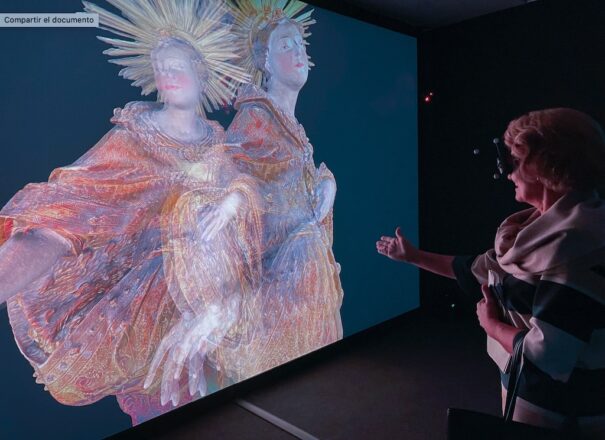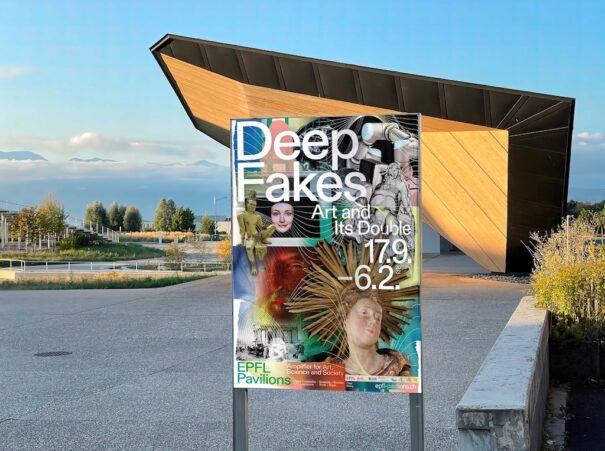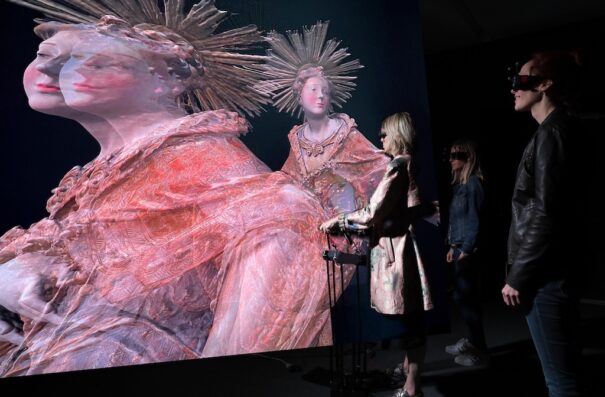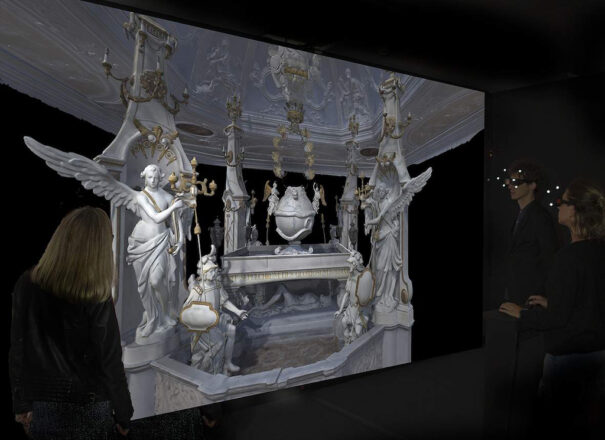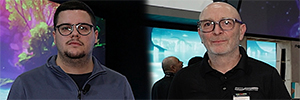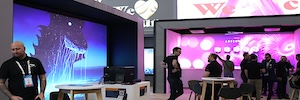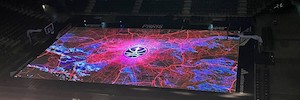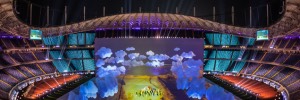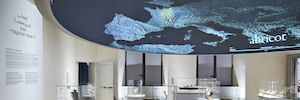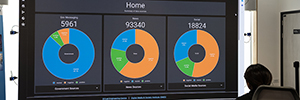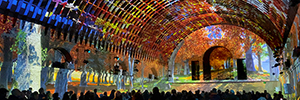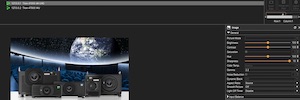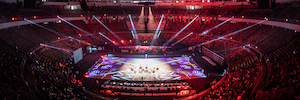Digital Projection energizes the exhibition 'Deep Fakes' with its 3D technology
Los visitantes de la vanguardista muestra ‘Deep Fakes’ de Lausana (Switzerland) pueden ver cómo el sistema Satellite MLS de Digital Projection, con la tecnología de proyección 3D Multi-View, reconstruye digitalmente la Abadía de Michaelsberg, un monasterio situado en Bamberg (Germany), patrimonio mundial de la Unesco.
The exhibition Deep Fakes: Art and its Double, que se celebra hasta el próximo mes de febrero en los EPFL Pavilions de Lausana (Switzerland), ofrece una muestra única de la cultura digital emergente que está agitando el mundo del arte.
Desde la artificial intelligence a la visión por ordenador, from the medios interactivos y de inmersión to the impresión 3D y 5D, la tecnología está revolucionando la forma de concebir, crear y experimentar el arte, and Deep Fakes es la primera exposición que aborda esta transformación a escala e intensidad.
With 1.000 m2 de superficie expositiva, Deep Fakes “es la culminación de varios años de nuevas prácticas creativas surgidas del mundo de la informática”, explica la comisaria de la muestra y directora de los EPFL Pavilions, Sarah Kenderdine, quien ha denominado a los nuevos elementos tecnológicos que toman prestadas, o se basan en obras de arte ya existentes, como unas “grandes falsificaciones culturales.
Para esta profesora de museología, con más de veinte años de experiencia en el desarrollo y la producción de exposiciones inmersivas e interactivas a gran escala para museos, así como para varios sitios del patrimonio mundial en Asia, como Angkor en Camboya, o el Olimpia de Grecia en Europa, “no hace mucho que los artistas y productores empezaron a entender plenamente el potencial de la producción computacional y las nuevas formas de arte”.
Entre las ‘grandes falsificaciones culturales’ que se exponen en los EPFL Pavilions, situados en el campus de la Escuela Politécnica Federal de Lausana (EPFL), se encuentran The Next Rembrandt, que utiliza la inteligencia artificial para crear una ‘nueva’ obra del maestro holandés; The Golden Calf, del artista multimedia Jeffrey Shaw, que solo se deja ver cuando el visitante rodea su pedestal en una ‘danza de veneración’, y la Abadía de Michaelsberg, en Bamberg (Germany), una reconstrucción digital completa del interior del monasterio, de mil años de antigüedad.
Además de las veintiún obras de arte de alta tecnología y las experiencias virtuales que se exponen, los visitantes de esta nueva muestra vanguardista pueden ver otra primicia tecnológica: la combinación del sistema Satellite MLS of Digital Projection with the technology of proyección 3D Multi-View para ayudar a reconstruir la Abadía de Michaelsberg, un monasterio benedictino patrimonio mundial de la Unesco.
La abadía física de Michaelsberg lleva cerrada por reformas desde que en 2012 se descubrieron daños estructurales. Como parte del proceso de restauración, la ciudad de Bamberg encargó al especialista en escaneado láser 3D ArcTron una recreación fotorrealista de alta resolución del interior de la iglesia, que contiene importantes obras de arte, esculturas y una arquitectura de finales del Renacimiento y del Rococó.
Innovación en RV y visualización
For Deep Fakes, el grupo de investigación sobre realidad virtual y visualización de la Universidad Bauhaus de Weimar, junto con la empresa Consensive, desarrollaron técnicas de renderización en tiempo real para los modelos 3D de ArcTron, lo que permite presentarlos en realidad virtual inmersiva mediante Multi-View, la tecnología de proyección 3D multiusuario de Digital Projection.
El sistema que está en Lausana de este fabricante, que también fue instalado por la Universidad de la Bauhaus, consta de un proyector Insight 4K HFR 360, junto con seis pares de gafas fabricadas por Volfoni.
Gracias a las velocidades ultrarrápidas de los fotogramas (360 Fps) exclusivas de Multi-View, este proyector es capaz de proporcionar una verdadera experiencia 3D a varios espectadores, cada uno con una visión de la exposición que se va adaptando a su cambio de posición. Esto permite que los usuarios vean e interactúen entre sí de una manera verdaderamente colaborativa.
“En lugar de proporcionar 120 Frames per second, que solo son suficientes para el 3D de un usuario, Insight Satellite MLS 4K HFR 360 ofrece una inmejorable visión de 360 fotogramas”, subraya Kenderdine, quien explica que la tecnología es sencillamente revolucionaria para los expertos en patrimonio, ya que puede aportar una experiencia compartida a todos los que contemplan una obra de arte digital.
“Proporcionar a cada usuario una perspectiva única de un objeto nos permite formas de colaboración totalmente novedosas”, recalca con entusiasmo Kenderdine.
En la especificación Satellite MLS (sistema láser modular), “el modelo Insight Satellite MLS 4K HFR 360 ofrece a los profesionales de los museos una solución aún más atractiva para las exposiciones multimedia modernas”, Ensures Thierry Ollivier, de Digital Projection y responsable de la participación del fabricante en el proyecto Deep Fakes.
Con Satellite MLS, el pequeño y ligero cabezal del proyector está disociado de la fuente de luz, lo que permite una proyección brillante en 4K con un tamaño compacto y una mínima generación de ruido/calor cerca de los objetos expuestos. “Este diseño único -añade Ollivier-hace que sea ideal para teatros y salas de ópera, edificios históricos y otras aplicaciones con restricciones de calor/espacio”.
Potencial tecnológico para la cultura
Tecnologías como Multi-View y Satellite MLS desempeñarán un papel cada vez más importante en las futuras exposiciones de arte y museos, donde el sistema AV ayudará a los visitantes a sumergirse en experiencias cada vez más interactivas.
“En el ámbito de los museos, estas herramientas ofrecen nuevas formas de contar historias: historias que no son necesariamente didácticas, historias que surgen y responden a la interacción de los usuarios e historias que los visitantes pueden encarnar y habitar – concluye Kenderdine-. El concepto audiovisual abre el archivo y le da mucho más potencial de reutilización. Ofrece a los artistas, creadores y conservadores un nuevo lienzo para crear marcos estéticos nunca vistos, y modalidades de compromiso que transportan y deleitan a los visitantes”.
En cuanto a la solución de Digital Projection en concreto, “el montaje ha funcionado como un sueño; tuvimos su asistencia remota y se puso en marcha en medio día. El público también parece encantado. Reconocen la diferencia; no se parece a nada que hayan visto antes. Los científicos de EPFL también han visitado la exposición en múltiples ocasiones para ver las nuevas oportunidades que ofrecen estas tecnologías”.
Ollivier no duda en subrayar el papel de la profesora Kenderdine “con quien he trabajado durante los últimos diez años en proyectos relacionados con la proyección y la realidad virtual; aplaudo su talento y sus esfuerzos por tender un puente entre la tecnología y el arte. With Deep Fakes, gracias a la combinación de los conocimientos de Digital Projection, Consensive y Volfoni, ella y su equipo han demostrado a un público diverso, desde autoridades culturales de prestigio mundial hasta estudiantes locales, cómo debe ser una experiencia de realidad virtual. Ver para creer”.
You liked this article?
Subscribe to our Feed And you won't miss a thing.
• Section: Fully, Case Studies, OUTSTANDING, FEATURED Case Study, Formation, Projection, Augmented reality, Simulation



